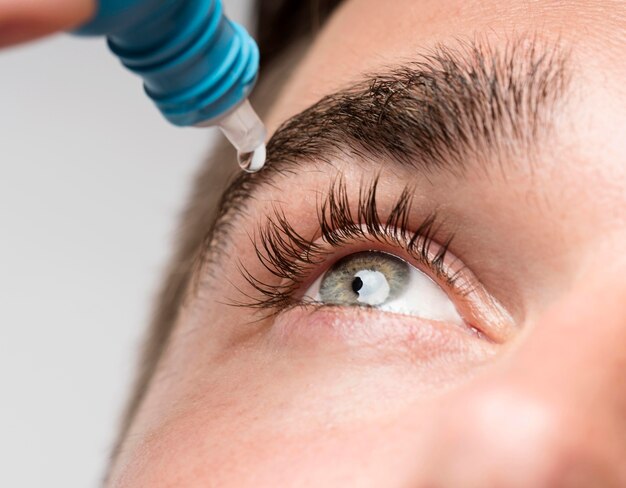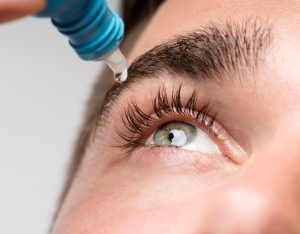health
Medical Experts Warn Against Applying Castor Oil to Eyes: A Health Alert Inspired by Social Media

Introduction
In the age of social media, health and beauty trends can spread like wildfire, often fueled by the allure of natural remedies. One such trend that has gained traction is the application of castor oil to the eyes, touted as a remedy for various concerns. However, medical experts are sounding the alarm and urging caution. In this health alert, we delve into why medical professionals are discouraging the use of castor oil for eye application, emphasizing the importance of prioritizing your eye health and making informed decisions.
The Castor Oil Trend: A Social Media Phenomenon
Social media platforms have become breeding grounds for health and beauty trends, with influencers and enthusiasts sharing their experiences and promoting natural remedies. Castor oil, known for its versatility and potential benefits, has captured the attention of many seeking alternative solutions. Videos and posts showcasing the application of castor oil to the eyes have garnered significant attention, leading to a surge in interest among those looking for quick fixes.
Understanding the Eye’s Delicate Nature
Before delving into the risks associated with castor oil application to the eyes, it’s crucial to understand the delicate nature of the eyes and the intricacies of their functioning. The eyes are highly sensitive organs that require specialized care to maintain optimal health and vision. The cornea, conjunctiva, and other structures work together to provide clear vision and protect the eyes from external irritants. Any foreign substance applied to the eyes, especially without proper knowledge or medical supervision, can potentially lead to complications.

Image by https://contrank.com/
Risks and Dangers of Castor Oil Application to Eyes
Medical professionals are united in their concern about applying castor oil to the eyes. While castor oil does have some potential benefits for the skin and hair, it is not intended for ocular use. The risks associated with applying castor oil to the eyes include:
- Irritation and Allergic Reactions: Castor oil contains compounds that may cause irritation or allergic reactions when they come into contact with the delicate tissues of the eyes.
- Disruption of Tear Film: The eye’s tear film is crucial for maintaining clear vision and preventing dryness. Applying castor oil could disrupt the tear film’s composition, leading to discomfort and blurred vision.
- Risk of Infection: The introduction of foreign substances into the eyes increases the risk of infection. Bacteria or contaminants present in castor oil could lead to eye infections, causing redness, pain, and potential vision impairment.
- Corneal Damage: Improper application of castor oil may inadvertently cause damage to the cornea, the transparent front part of the eye. Corneal injuries can lead to vision problems and require medical intervention.
Safe and Effective Alternatives for Eye Health
Rather than resorting to unverified remedies, it’s advisable to prioritize your eye health by seeking guidance from qualified medical professionals. If you experience eye discomfort, dryness, or any other concerns, consult an eye doctor for appropriate diagnosis and treatment. For maintaining eye health and addressing minor issues, consider the following safe and effective alternatives:
- Artificial Tears: Over-the-counter artificial tear solutions can provide relief from dry eyes and help maintain the eye’s natural moisture balance.
- Warm Compresses: Warm compresses applied to closed eyelids can help alleviate eye discomfort and promote a healthy tear film.
- Proper Hygiene: Practicing good eye hygiene, such as avoiding rubbing your eyes and removing contact lenses before sleep, can prevent irritation and potential infections.
- Regular Eye Exams: Schedule regular eye examinations with an optometrist or ophthalmologist to monitor your eye health and detect any issues early.
In conclusion,
the allure of natural remedies and trends on social media should always be approached with caution, especially when it comes to matters as delicate as eye health. Medical experts emphasize the risks and dangers associated with applying castor oil to the eyes and recommend seeking professional guidance for any eye-related concerns. Prioritizing your eye health through safe and evidence-based practices is the key to maintaining clear vision and overall well-being.
Care
Natural Headache Relief: The Massage Therapy Solution

Headaches disrupt everything. They break your focus at work. Even ruin your sleep. They strain time with family and friends. Many people immediately choose pain medicine. It feels quick and easy. However, medicine often just masks the pain. It rarely solves the underlying problem. The pain usually returns.
Maybe you want a different solution. You might seek an approach that helps your body heal. Massage therapy is now a powerful option. It specifically targets tight muscles and stress patterns. These issues commonly cause headaches. Correctly applied, massage can reduce your pain naturally.
This guide explains exactly how headache massage works. Learn why it offers a reliable path to long-term relief.

How Massage Reduces Pain Naturally
Massage supports your body’s own healing process. It does not just cover symptoms. Let’s explore the key mechanisms.
First, it releases muscle tension.
Tight neck and shoulder muscles often trigger pain. Desk jobs and phone use strain these areas. This tension presses directly on nerves. Then, pain signals shoot to your head. Massage applies steady, deliberate pressure. It loosens these specific muscles. Reduced tension decreases nerve pressure. You will feel less stiffness. Fewer pain signals will fire. Regular sessions keep muscles relaxed longer. This directly prevents many headaches from starting.
Next, it improves blood circulation.
Tight muscles restrict healthy blood flow. Your head and neck then get less oxygen. Poor circulation can intensify headache pain. Massage gently manipulates soft tissue. This action encourages better blood flow. Improved circulation helps tissues heal and recover. Many people feel immediate warmth and ease in their neck afterward. Better blood flow can lower both the intensity and duration of headaches over time.
Additionally, it calms your nervous system.
Stress is a major headache trigger. It keeps your body in a tense “fight or flight” state. Your breathing becomes shallow. Muscles tighten unconsciously. This buildup often explodes into a headache. Massage triggers your relaxation response. It shifts your nervous system into a “rest and digest” state. Your muscles unwind. Your breathing deepens. This breaks the stress-pain cycle. You gain a tool to manage tension before it becomes a headache.
Also, it corrects posture problems
Your posture directly impacts headaches. Forward head posture (like looking at a screen) strains your neck muscles. This strain builds slowly but surely. It creates perfect conditions for chronic pain. Massage targets these overworked postural muscles. It releases the tight areas that pull your skeleton out of line. As your posture improves, mechanical strain on your neck decreases. This leads to fewer headaches and more daily comfort.
Critically, it offers sustainable relief
Medicine has its place for acute crises. However, long-term reliance poses problems. These include side effects and medication-overuse headaches. Massage provides a different, sustainable path. It builds body awareness and supports natural function. You can use it regularly without negative consequences. Many people combine it with stretching and stress management. This creates a holistic, proactive routine.
What to Expect from a Session
A professional headache massage is highly targeted. It is not a general relaxation session. First, your therapist will ask detailed questions. They will want to understand your pain patterns, daily activities, and medical history. This assessment guides their hands-on work.
The treatment typically focuses on your upper body. Key areas include your suboccipital muscles (skull base), neck, shoulders, and upper back. Therapists use specific techniques like myofascial release and trigger point therapy. They apply precise pressure to release muscle “knots” and tight fascia. The pressure is firm but should not cause sharp pain. Communication with your therapist is essential. Always tell them if the pressure is too much.
A session usually lasts between 30 to 60 minutes. Afterwards, you might feel deeply relaxed. Some mild soreness is possible, similar to post-exercise feeling. This normally fades within a day. Drink plenty of water. This helps flush metabolic waste released from your muscles.
Building a Long-Term Strategy
For chronic headaches, consistency matters. One massage might offer temporary relief. A series of sessions creates lasting change. It retrains tense muscles and resets poor posture. Many people start with weekly sessions. They then move to bi-weekly or monthly maintenance.
Your therapist can also give you tools for home. They may teach you simple neck stretches or self-massage techniques. They might advise on desk ergonomics or stress-reduction practices. This empowers you to take control between appointments.
Making the Choice for Your Health
Headaches can control your life, but you have options. If your pain stems from tension, stress, or posture, massage addresses these roots directly. It is a practical, drug-free method to reduce pain frequency and severity.
Choose a qualified professional. Look for a licensed massage therapist experienced in clinical or therapeutic work. Be clear about your headache history and goals.
Commit to a plan. Partner with your therapist. Give the process a few sessions to work. Combine hands-on care with the lifestyle changes they recommend.
Ultimately, this approach is about more than pain relief. It is about reclaiming your focus, your sleep, and your daily joy. It is an investment in a life with fewer interruptions and more comfort. Take the step toward lasting relief. Your body—and your calm, clear head—will thank you.
Care
Why CBD Intimacy Oil Is the Must-Try Product of the Year

Connection begins long before any physical moment. It starts with how relaxed you feel in your body and how present you are with yourself. That is why more people are turning toward plant-based wellness to support intimacy in a more natural way.
Products inspired by healing spirits herbs focus on calming the nervous system, supporting sensitivity, and creating an environment where closeness feels easy rather than forced. This shift reflects a deeper desire for comfort, trust, and genuine connection.
As conversations around wellness grow more open, CBD intimacy oil has moved into the spotlight. Many people actively search for CBD intimacy oil for sale because it offers a gentle, supportive option rather than an aggressive solution. Instead of masking discomfort or pushing the body, it works with natural rhythms to encourage relaxation and ease. That alone makes a noticeable difference in how intimate moments unfold.

What makes CBD intimacy oil different from traditional products
Unlike conventional lubricants or enhancement products, CBD intimacy oil supports the body on multiple levels. It does not rely on numbing agents or synthetic stimulants. Instead, it focuses on comfort, circulation, and calm.
Key qualities that set it apart include:
- Plant-based ingredients that feel gentle on sensitive skin
- CBD compounds are known for their soothing and relaxing effects
- Oils that nourish the skin rather than dry it out
- A focus on comfort instead of performance pressure
These qualities allow intimacy to feel more organic and less goal-driven.
CBD works with the body’s endocannabinoid system, which plays a role in regulating stress, sensation, and balance. When the body feels safe and relaxed, it naturally becomes more receptive. This is why many people report improved comfort and awareness when using CBD-infused products during intimate moments.
The emotional side of physical comfort
Physical ease and emotional connection often move together. When the body holds tension, the mind follows. CBD intimacy oil helps reduce that tension, which allows people to stay present rather than distracted.
Reduced discomfort leads to:
- Less anxiety around intimacy
- Greater confidence in one’s body
- Improved communication with a partner
- A slower, more mindful pace
These changes may feel subtle at first, but they build over time. Intimacy becomes less about effort and more about shared experience.
Wellness routines outside the bedroom also play a role. Many people who explore CBD intimacy oil already value calming rituals throughout the day. Practices like stretching, quiet evenings, or choosing to buy herbal teas and tisanes help create a relaxed baseline. When the nervous system feels supported daily, intimate moments feel more natural and enjoyable.
How to use CBD intimacy oil with intention
Using CBD intimacy oil works best when you slow down and stay attentive. Rushing defeats the purpose. Treat the oil as part of the experience, not a tool to get past discomfort as quickly as possible.
Helpful guidelines include:
- Start with a small amount and add more only if needed
- Warm the oil between your hands before applying
- Use slow, mindful touch rather than quick movements
- Communicate openly about comfort and preferences
This approach turns the application into a shared ritual instead of a mechanical step.
Many couples find that intention matters as much as the product itself. Setting aside distractions, lowering lights, or playing calming music helps reinforce the sense of safety and presence. CBD intimacy oil simply supports what the environment already encourages.
Choosing quality and transparency
Not all CBD products meet the same standards. Ingredient quality, sourcing, and formulation matter, especially for intimate use. Reputable wellness brands focus on clean ingredients and clear labeling.
When choosing a product, look for:
- Third-party testing for purity and potency
- Simple ingredient lists without harsh additives
- Clear guidance on usage and storage
- Brands that prioritize education, not hype
This level of transparency builds trust and ensures the product aligns with a holistic approach to wellness.
Many people prefer shopping through a trusted apothecary in Denver or similar wellness-focused retailer because these spaces emphasize quality, ethics, and customer education. This makes it easier to choose products that truly support well-being rather than chase trends.
Why CBD intimacy oil fits modern wellness values
Today’s wellness culture values balance, consent, and self-awareness. CBD intimacy oil fits naturally into this mindset. It does not promise instant transformation. Instead, it supports comfort, communication, and connection over time.
This product resonates because:
- It respects the body’s natural responses
- It encourages slower, more mindful experiences
- It aligns with plant-based and holistic lifestyles
- It supports intimacy without pressure or expectations
These qualities reflect a broader shift away from quick fixes and toward sustainable well-being.
CBD intimacy oil has earned its place as a must-try product because it supports both body and mind. Easing tension, improving comfort, and encouraging presence help intimacy feel more natural and connected. When paired with thoughtful self-care and honest communication, it becomes part of a wider wellness practice that values depth over speed and connection over performance.
health
Long-Term Asthma Management: Safeguarding Lung Health

Breathing easily today is vital, but ensuring that you can breathe well for the next ten years is even more essential. This is where the expertise of an Asthma Specialist becomes invaluable. Asthma isn’t merely about managing occasional symptoms; it fundamentally involves safeguarding your lungs for a lifetime.
Many people tend to seek medical assistance only when their symptoms flare up. However, maintaining long-term respiratory health relies on consistent care, timely adjustments, and a deep understanding of how your lungs change over time.

Asthma: A Long-Term Condition
Asthma is not a fleeting illness that disappears once symptoms lessen. Even during seemingly “good phases,” inflammation may still be silently active, posing risks to lung health. An Asthma Specialist looks beyond immediate symptom relief and emphasizes long-term lung preservation.
This proactive approach can help prevent a gradual decline in lung capacity that often goes unnoticed until everyday activities become increasingly challenging. Regular check-ups and ongoing monitoring are essential. These enable specialists to evaluate lung function and adjust treatment plans accordingly.
Engaging in proactive management strategies, such as making lifestyle changes and adhering to prescribed medications, is crucial for effective asthma control. Additionally, educating patients about potential triggers and avoidance strategies equips them to manage their condition more effectively.
The Significance of Long-Term Monitoring
Over time, the triggers for asthma may transform. Stress levels fluctuate, and work environments change. A proficient Asthma Specialist monitors these variations and tailors treatment as necessary. What worked two years ago may no longer be sufficient, and routine follow-ups help catch issues early.
Picture this process like maintaining a car: regular service prevents breakdowns rather than merely addressing problems after they occur.
Personalized Care: A Tailored Approach
Every asthma patient is unique, influenced by factors like lifestyle, allergies, sleep patterns, and emotional well-being. An Asthma Specialist envisions a personalized care plan that fits into the patient’s real life rather than disrupting it.
This tailored approach enhances adherence to treatment and proves far more effective in the long run.
Preventing Flare-Ups: A Proactive Strategy
Emergency visits frequently occur when subtle warning signs are overlooked. An Asthma Specialist educates patients to recognize early changes in their breathing and take action before symptoms escalate.
By implementing this proactive strategy, patients can reduce hospital visits and missed workdays, alleviating unnecessary anxiety.
Education: Core to Long-Term Care
One often-overlooked role of an Asthma Specialist is the emphasis on education. By teaching patients the correct inhaler technique, trigger avoidance, and how to track symptoms, specialists empower individuals to take control of their asthma management.
Patients who have a thorough understanding of their condition tend to experience fewer flare-ups and better overall control.
The Importance of Expertise in Chronic Asthma Care
Effective long-term asthma management demands experience rather than guesswork. Specialists like Dr. Sanchayan Roy are known for aiding patients in achieving stable lung health over years, rather than only addressing symptoms as they arise.
Experience enables healthcare providers to recognize subtle changes before they escalate into serious problems.
Patient Experiences Post-Diagnosis
Many patients express a common realization: “I didn’t know breathing could feel this effortless.” That moment of clarity highlights why Asthma Specialists look beyond mere symptoms.
When breathing improves, it positively impacts other life areas—energy levels rise, focus sharpens, and confidence grows.
Early Identification: Minimizing Long-Term Damage
If asthma goes undetected, lingering inflammation can silently continue to affect the airways. Over time, this may lead to lasting damage. An Asthma Specialist aims to intervene early when treatment is more straightforward and lung function is recoverable.
Taking early action protects future breathing capabilities.
Choosing the Right Care: The Need for Expertise
Not all breathing issues are readily identifiable. Consulting with the Best Asthma Doctor in Delhi ensures access to advanced diagnostic tools, clinical expertise, and ongoing monitoring. A skilled Asthma Specialist doesn’t rush to conclusions; rather, they approach each case with meticulous care.
This level of detailed attention can often prevent years of unnecessary discomfort.
Urban Living: Managing Long-Term Lung Health
Living in urban environments exposes individuals to pollution, allergens, and stress. An Asthma Specialist tailors treatment plans to address these urban challenges, minimizing the cumulative impact of triggers on lung health.
This tailored guidance is particularly important for those who notice a gradual decline in their breathing over time.
The Benefits of Ongoing Specialist Care
Patients frequently report that they were unaware of how restricted their breathing had become until improvements were made. An Asthma Specialist focuses on restoring comfort, stamina, and confidence—not merely managing attacks.
Long-term care isn’t about limitations; it’s about achieving freedom in daily life.
The Best Asthma Doctor in Delhi: Choosing the Right Partner
For long-lasting respiratory health, many patients search for the Best Asthma Doctor in Delhi—someone who provides continuity, advanced diagnostics, and a strategic vision for lung health. The right Asthma Specialist becomes a partner in health rather than just a consultant.
Prioritizing Future Lung Health Starts Today
Asthma management isn’t solely about immediate relief. An Asthma Specialist strives to ensure that your lungs remain robust, flexible, and functional for years to come, eliminating the need to constantly think about breathing.
Conclusion
Long-term respiratory health is not a matter of luck; it is cultivated through informed care, vigilant monitoring, and expert guidance. The role of an Asthma Specialist transcends symptom control; it is fundamentally about protecting lung function for life. With a patient-centered approach and support from the Best Asthma Doctor in Delhi, managing asthma becomes more predictable and far less intrusive. Learn how an Asthma Specialist in your area can facilitate long-term respiratory health through early intervention, comprehensive monitoring, and personalized care.
-
Business2 years ago
Cybersecurity Consulting Company SequelNet Provides Critical IT Support Services to Medical Billing Firm, Medical Optimum
-
Business3 years ago
Team Communication Software Transforms Operations at Finance Innovate
-
Business3 years ago
Project Management Tool Transforms Long Island Business
-
Business2 years ago
How Alleviate Poverty Utilized IPPBX’s All-in-One Solution to Transform Lives in New York City
-
health3 years ago
Breast Cancer: The Imperative Role of Mammograms in Screening and Early Detection
-
Sports3 years ago
Unstoppable Collaboration: D.C.’s Citi Open and Silicon Valley Classic Unite to Propel Women’s Tennis to New Heights
-
Art /Entertainment3 years ago
Embracing Renewal: Sizdabedar Celebrations Unite Iranians in New York’s Eisenhower Park
-
Finance3 years ago
The Benefits of Starting a Side Hustle for Financial Freedom































